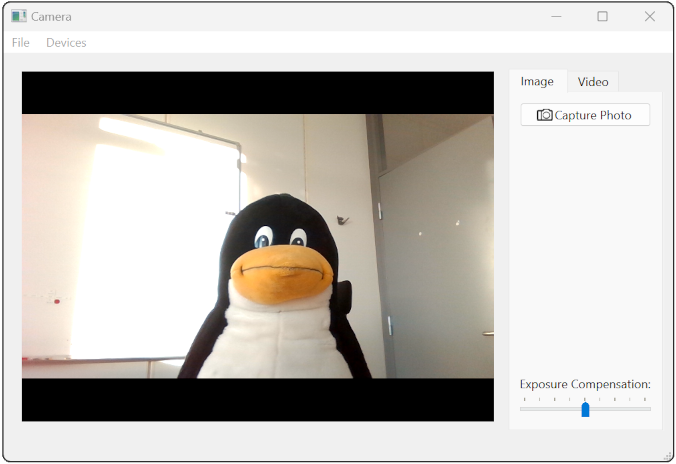Shows how to capture a still image or record video.

摄像头范例演示如何使用 Qt Multimedia 实现一些基本摄像头功能以获得静止图像和录制带音频的视频剪辑。
要运行范例从 Qt Creator ,打开 Welcome 模式,然后选择范例从 Examples 。更多信息,拜访 构建和运行范例 .
The example implements a
Camera
class that acts as our camera interface. It has a user interface, control functions, setting values and a means of defining the location where the image or video clip is to be saved. It will also store the image and video settings.
The Camera class uses:
The Camera constructor does some basic initialization of the user interface including disabling all buttons by default.
Camera::Camera() : ui(new Ui::Camera) { ui->setupUi(this); // disable all buttons by default updateCameraActive(false); readyForCapture(false); ui->recordButton->setEnabled(false); ui->pauseButton->setEnabled(false); ui->stopButton->setEnabled(false); ui->metaDataButton->setEnabled(false);
It seeks permissions for input device access:
#if QT_CONFIG(permissions) // camera QCameraPermission cameraPermission; switch (qApp->checkPermission(cameraPermission)) { case Qt::PermissionStatus::Undetermined: qApp->requestPermission(cameraPermission, this, &Camera::init); return; case Qt::PermissionStatus::Denied: qWarning("Camera permission is not granted!"); return; case Qt::PermissionStatus::Granted: break; } // microphone QMicrophonePermission microphonePermission; switch (qApp->checkPermission(microphonePermission)) { case Qt::PermissionStatus::Undetermined: qApp->requestPermission(microphonePermission, this, &Camera::init); return; case Qt::PermissionStatus::Denied: qWarning("Microphone permission is not granted!"); return; case Qt::PermissionStatus::Granted: break; } #endif
Inputs are assigned:
m_audioInput.reset(new QAudioInput);
m_captureSession.setAudioInput(m_audioInput.get());
// Camera devices:
videoDevicesGroup = new QActionGroup(this);
videoDevicesGroup->setExclusive(true);
updateCameras();
UI signals are connected to slots that react to the triggering event:
connect(&m_devices, &QMediaDevices::videoInputsChanged, this, &Camera::updateCameras);
connect(videoDevicesGroup, &QActionGroup::triggered, this, &Camera::updateCameraDevice);
connect(ui->captureWidget, &QTabWidget::currentChanged, this, &Camera::updateCaptureMode);
connect(ui->metaDataButton, &QPushButton::clicked, this, &Camera::showMetaDataDialog);
connect(ui->exposureCompensation, &QAbstractSlider::valueChanged, this,
&Camera::setExposureCompensation);
setCamera(QMediaDevices::defaultVideoInput());
However, most of the work is done when the setCamera() function is called, passing in a QCameraDevice .
setCamera()
sets up various connections between the user interface and the functionality of the Camera class using signals and slots. It also instantiates and initializes the
QCamera
,
QImageCapture
,和
QMediaRecorder
对象。
void Camera::setCamera(const QCameraDevice &cameraDevice) { m_camera.reset(new QCamera(cameraDevice)); m_captureSession.setCamera(m_camera.data()); connect(m_camera.data(), &QCamera::activeChanged, this, &Camera::updateCameraActive); connect(m_camera.data(), &QCamera::errorOccurred, this, &Camera::displayCameraError); if (!m_mediaRecorder) { m_mediaRecorder.reset(new QMediaRecorder); m_captureSession.setRecorder(m_mediaRecorder.data()); connect(m_mediaRecorder.data(), &QMediaRecorder::recorderStateChanged, this, &Camera::updateRecorderState); connect(m_mediaRecorder.data(), &QMediaRecorder::durationChanged, this, &Camera::updateRecordTime); connect(m_mediaRecorder.data(), &QMediaRecorder::errorChanged, this, &Camera::displayRecorderError); } if (!m_imageCapture) { m_imageCapture.reset(new QImageCapture); m_captureSession.setImageCapture(m_imageCapture.get()); connect(m_imageCapture.get(), &QImageCapture::readyForCaptureChanged, this, &Camera::readyForCapture); connect(m_imageCapture.get(), &QImageCapture::imageCaptured, this, &Camera::processCapturedImage); connect(m_imageCapture.get(), &QImageCapture::imageSaved, this, &Camera::imageSaved); connect(m_imageCapture.get(), &QImageCapture::errorOccurred, this, &Camera::displayCaptureError); }
The still and video recording visual tabs are enabled:
m_captureSession.setVideoOutput(ui->viewfinder);
updateCameraActive(m_camera->isActive());
updateRecorderState(m_mediaRecorder->recorderState());
readyForCapture(m_imageCapture->isReadyForCapture());
updateCaptureMode();
Finally the start () function of the QCamera object is called.
m_camera->start();
Now that the camera is ready for user commands it waits for a suitable event. Such an event can be a key press of either the Qt::Key_CameraFocus or Qt::Key_Camera buttons on the application window.
Key_CameraFocus will simply display the preview and lock the camera settings.
} void Camera::keyPressEvent(QKeyEvent *event) { if (event->isAutoRepeat()) return; switch (event->key()) { case Qt::Key_CameraFocus: displayViewfinder(); event->accept(); break;
Key_Camera
will either call
takeImage()
if doing an image capture, or call
record()
or
stop()
(if already recording) on the
QMediaRecorder
instance when recording video.
case Qt::Key_Camera:
if (m_doImageCapture) {
takeImage();
} else {
if (m_mediaRecorder->recorderState() == QMediaRecorder::RecordingState)
stop();
else
record();
}
event->accept();
break;